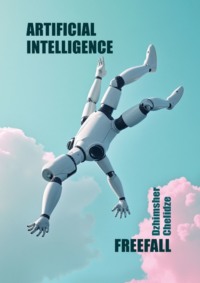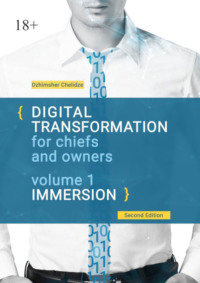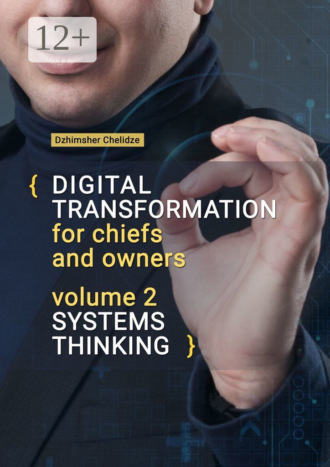
Полная версия
Digital transformation for chiefs and owners. Volume 2. Systems thinking
But his successor had a classical management education. He formed a team of managers, a system of reports. But what do employees want? To keep them safe and stable. That’s normal. However, with each step, from each leader the information becomes more distorted, and as a result, a distorted view of the situation is formed at the very top, which means that decisions are made based on the erroneous opinion. This is, for example, one of the main problems of public administration.
If this rule is combined with high-quality, automated data collection, transparent analytics, this problem can be avoided.
As a result, solving problems and improving processes, you need to see what is happening and personally check the data, rather than theorize, listening to other people or looking at the computer monitor. Thinking and reasoning must be based on data that are verified and sure. Even company executives and business executives must see the problem for themselves, only then will the understanding of the situation be genuine, not superficial.
Principle 13. Take your decision slowly, on the basis of consensus, weighing all possible options; when implementing it, do not delay (nemavasi).
It can also be called «think slowly, decide quickly». One of the basics of management is the need to evaluate alternatives. Making decisions based on one opinion is too dangerous and risky. If this is sometimes the only development option for young companies, the further, the more often it is necessary to use consensus, and this requires the development of the issue and several people with different opinions and psychotypes. On this, among other things, the concept of Adizes is based – one person cannot combine all the necessary competencies, you need a versatile team. To that end, it was necessary to learn to discuss views openly and to overcome conflicts.
As a result, one cannot make a clear decision on the way forward without weighing all the alternatives. In this case, there are less risks and the desire to go back and redo. And when a decision has already been made, you need to act. For example, when Toyota was developing her Prius, she worked very hard on possible variations of the hybrid approach. However, by assessing possible alternatives, they focused on one option and promoted it only, it became the de facto standard worldwide.
Nemavashi is a process of joint discussion of problems and potential solutions in which everyone participates. His job is to gather all the ideas and develop a consensus on where to go next. While such a process is time-consuming, it helps to broaden the search for solutions and to prepare the ground for rapid implementation.
Principle 14. Become a learning entity through tireless introspection (Hansei) and continuous improvement (Kaizen).
Do you think it’s possible to optimize everything? Right, in the beginning, we said that goals, objectives, technologies, products can change, and that means we need to constantly improve.
What are the approaches? You can hire consulting agencies, you can initiate regular modernization and restructuring. But with this approach, people will pretty quickly become disappointed in all this, and a culture of inert to any changes will begin to form: people will have in mind the idea that it will pass.
The Japanese prefer to follow the path of constant development in small steps, initiating changes from the performers. Additionally, for example, in digitalization – you can initiate a giant program of digital transformation, invest huge resources, and the output does not get effect.
It is better to start with the small stages of digitalization, and then, when the competencies and the conscious understanding of the need for global digitalization are formed, begin to implement global systems.
In the first book, I already gave examples of both cases: a failed implementation experience at once A total and expensive asset management system and a successful experience of using free Google tools to organize production. It’s not necessarily the right path, but I’m a proponent of that evolution.
To realize this principle, it is necessary to:
– once the process has stabilized, use tools for continuous improvement;
– create such a process that almost does not require reserves. This will immediately identify the loss of time and resources and do not start the «disease». When losses are obvious to all, they can be eliminated through continuous improvement (Kaizen);
– collect and preserve company knowledge, prevent staff turnover (i.e., understand the nature of motivation), monitor the progressive promotion of employees and preserve the accumulated experience;
– at the completion of projects, including implementation, carry out gap analysis (hansey) and openly talk about them. Following the analysis – implement changes in business processes;
– standardize the best techniques and techniques instead of inventing a wheel every time a manager changes, that is, describing business processes.
Muda, Mura, Muri and Loss Types
Mud, moody, moody are strange words, aren’t they? The essence is simple.
Let’s look at these basic concepts.
Muda is two kinds of loss:
1. Actions that do not create value but are unavoidable. For example, transportation, paperwork – it is impossible to remove them from the process, but it is necessary to strive to reduce, say, automation of preparation of mandatory reporting. In my experience, with the help of ordinary Exel, I was able to reduce the labor cost of a mandatory and unnecessary report from 8 hours per month to 30 minutes.
2. Actions that do not create value at all and should be excluded from the process completely. For example, waiting, stocks, marriage, etc.
Mura is uneven. If demand is uneven, queues are formed, execution time increases. Additional materials and supplies are required to meet peak demand. Working in emergency mode tires people and reduces their efficiency and quality of work.
All this also generates losses – marriage, waiting, excess supplies, the need to redo.
Moody is an overload of people or equipment.
We make machines or people work to the limit. Overloading people threatens their safety and causes quality problems. Overloading equipment leads to accidents and defects, which in the end also leads to losses.
These three «M» represent a single system.
Often the root of the problems – «Mura», as unevenness leads to overload «Muri», which in turn causes many other losses («Muda»).

3M: Muda, Mura and muri
Let me remind you that the goal of digitalization, automation and transformation is to reduce losses, mainly in working with information. Additionally, before we initiate any project, we need to understand what losses we want to eliminate.
1. Overproduction
The most common problem, which is the cause of most others. Remember the example in systems restriction theory where the sales department sold more than it could produce? Or when we make five copies of documents, when you only need one? All this is overproduction. This leads to overburdening of units, and high stocks of unfinished production or finished products in warehouses, which also increases the number of rejects.
Reasons – large batches production and unexplored demand, long retraining / restructuring.
Planning systems and deep market intelligence through big data collection can help.
2. Waiting
This is all the time during which people or equipment expect resources, technological operation, data, unnecessary coordination. The e-workflow projects are also designed to address these losses. It is only in such projects often forget to do rewrite processes, and then the electronic workflow begins to complicate the life of employees.
The reasons for the occurrence – a violation in the logistics system. For example, the boss left, and documents can only be signed manually. Or equipment failure, lack of guidance from management, lack of planning.
3. Inventories
Many buyers like to buy large batches to get a discount, even if they do not need so much material yet. Excessive stockpiles freeze money in themselves, plus all this must be stored somewhere, large warehouses are required. In addition, in the warehouse may be defective raw materials. In this type of losses hide the problems of production planning and uneven processes.
The reasons for the appearance – uneven production and poorly established relations with suppliers of materials, do not take into account the demand for products or raw materials.
Example: storage of large quantities of materials needed for production during six months, excluding warehouse maintenance costs, or production of New Year’s goods without seasonal demand.
4. Excess transport
Moving materials or goods between units that do not add value to the final product or service. This leads to both idle / waiting equipment, and unnecessary marriage.
Causes of occurrence – irrational use of production / office space, unnecessary intermediate storage areas, inconvenient equipment placement, non-optimized business processes.
Example: Location of the spare parts warehouse and production at a greater distance from each other.
5. Excessive displacement of people
Unnecessary staff movements or chaotic organization of workplaces. This loss is often combined with the previous, especially in the office. Therefore, here’s an example. The organization has an electronic workflow system, but people still need to print and archive every application manually. As a result, unnecessary movement of documents and people. If we are talking about production, then while a person is walking on the floor, he can damage other products.
The reasons for the emergence – irrational organization of the work space, lack of work standards, lack of visualization, violation of work discipline.
Example: search for the necessary tool for the operation of the entire site, the lack of knowledge of the staff of the areas of responsibility and walking, the determination of who should perform a particular operation, the lack of visual standards that facilitate the search for necessary tools and materials.
For example, a business process system, big data sensors and geolocation sensors for moving people within business processes will help.
6. Marriage
Marriage is dangerous because it is not only the disposal of raw materials and working time of machines and people in the junk, but also the reputation of customers.
The reasons for the appearance – lack of control at different stages of the production process, lack of built-in system «Protection against Fool» (Bye-yoke), lack of qualification of people or equipment problems.
Back to digitalization, the most common solution here is machine vision systems that analyze process and product.
7. Overservice
It means all those actions when we try to do better than the consumer needs.
The reasons for this are an unknown demand or a lack of incoming information.
If we go back to project and product management statistics, only 16% of the products are completely successful. Why?
One of the factors is the excessive number of possibilities in products. Only 20% of the built-in functionality is in demand regularly, 30% – occasionally, and 50% – almost never. To be even more visible, let’s remember modern applications, for example, banking. What do you really use? Additionally, did it become more convenient to use your banking application in comparison with what was five years ago? Personally, I do not. Micro-service solutions are becoming more functional, but less convenient and demanded. But their development costs money.
To simplify the example, remember the remote for the TV with a set of additional features that the consumer does not need.
8. Untapped human potential
The final loss type, according to Toyota, is unused or unrealized human potential. As the name suggests, this is the exclusion of the personal qualities, knowledge, skills and skills of the employee from the work performed by him. Unrealized human resource losses most often occur when the staff member is expected to perform exceptional routine operations, the manager does not listen to subordinates, and any activity is strictly regulated by internal standards, rules or duties.
Additionally, as practice shows, this is one of the most common phenomena. At the beginning of the book, I said that one of the limitations is the thinking of the manager, and top managers are usually bright and authoritarian entrepreneurs who love micromanagement and do not trust the regular staff, are not ready to hear different opinions. Although sometimes it is skilfully masked. In the end, we get this kind of loss. And if the head is also in a large company with a bureaucratic structure and culture, generally trouble.
The causes are an inefficient system of motivation, high competition among staff, excessive control by management, lack of motivation or even punishment for showing initiative.
It is also common for an employee to perform non-core tasks, work for himself, for a colleague and for Ivan.
All these losses are relevant for any working system, both production and office. Including when implementing digital tools. Additionally, digitalization automation is about reducing the amount of routine work that people do.
Also below is a table with examples of losses for production, office and IT.
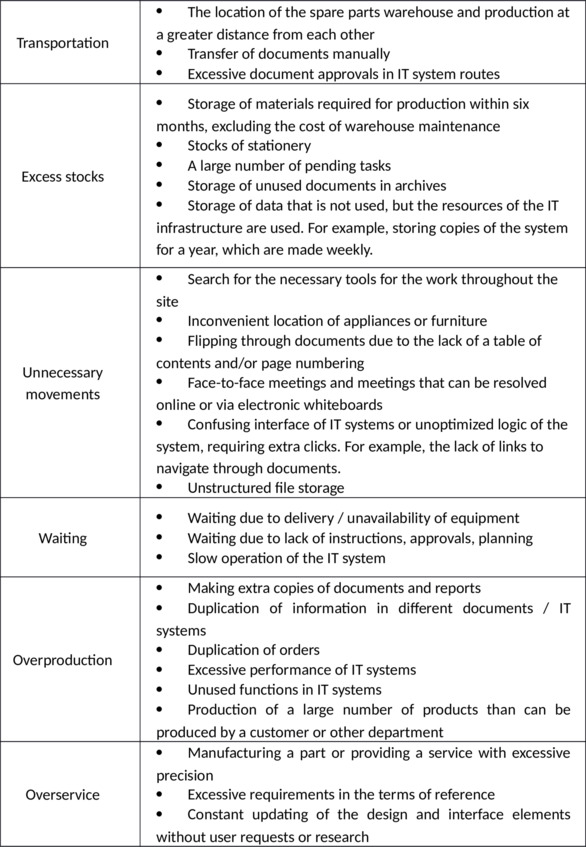

Key tools
Kaizen
Kaizen is a Japanese philosophy that focuses on continuous process improvement in small steps. The point is, the people on the ground know best what can be done. This instrument was also in the USSR, but was called the system of rationalization proposals.
For this to work, it is necessary:
constantly collect feedback and implement changes, and if they are not applicable, you need to explain to the initiator what is wrong;
people need to be trained to direct not just desires, but rational sentences, plus this will not waste time on long conversations.
This not only improves processes but also motivates employees.
In my practice, the best initiatives (the least costly and most effective) came from ordinary employees.
Examples:
1. During the production, there may be a defect or not the entire order can be made (did not have time, the components did not arrive). As a result, the packers explain the details to the head of production, and he – the planning and sales department.
The solution from the packers – put the number of each part in the drawing itself. Implementation in 1C – a couple of days.
Outcome:
planners simply give a report and drawings
the planner immediately knows what to reload, and says when the missing item comes;
the sales department clearly understands when the order is ready.
2. Feedback from operators.
Having changed the location of consumables, it was possible to reduce the time for re-ordering between orders by 50%: it was just not necessary to go to the other end of the workshop, along the way and hitting other orders.
Do you think the combination of such an approach and digital tools will have more effect than buying expensive control systems, but with chaos in normal work?
For digitalization it is generally a «magic pill». Once people accept that they can change the workflow and acquire the necessary competencies, they themselves will begin to simplify their work, including automating and repartitioning processes. The main thing is not to «encourage» them even more routine.
Well, not all employees, but 10—15% of active innovators are able to turn everything around. It is them that should be highlighted and trained system approach.
If we look at the experience of Japanese companies, then in each production workshop there is a tablet where each employee can leave a proposal.
Kanban system
«Kanban» in Japanese means «sign», «signal» or «card». Initially it is a tool with cards to request raw materials in the production shop.
These are now IT solutions for the organization of work. Their essence is creation of «pulling system», when work is taken only after completion of the previous, as well as visualization of the work process, prevention of overloading of people or units, identification of problems at an early stage and improvement of the process. We will look at this tool in more detail in the chapter on project management, as it is one of the main ones in flexible approaches.
7 Practical Problem-Solving Steps
In lean production there is a tool «7 steps of practical solution of problems».
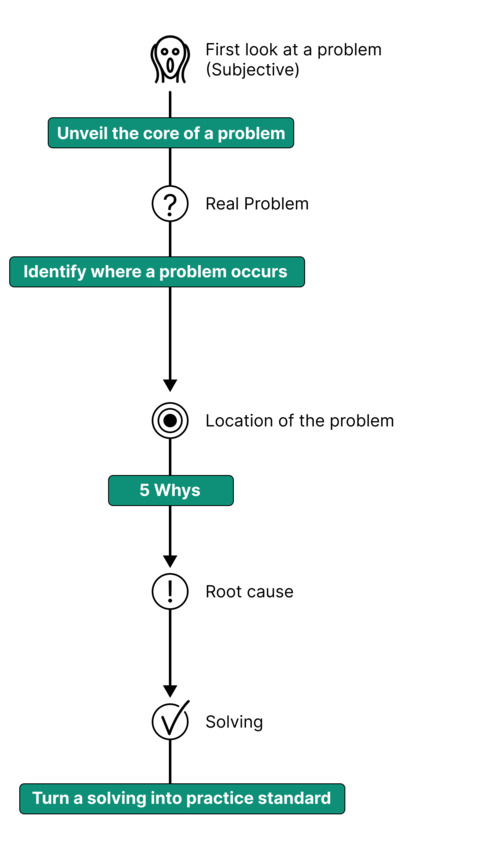
Solving problems in lean production
It also uses 2 tools – 5W1H to assess the situation and «5 why» to determine root causes and build cause-effect relationships.
In 5W1H you have to answer 6 questions:
– Who faced the problem (who)?
– What happened (what)?
– When?
– Where?
– Why did you have to do this (why)?
– How did the problem arise as a result of what actions (how)?
Additionally, then we work through «5 why». I first encountered this tool in one project where IKEA worked: when delivering defective products, you are forced to conduct an investigation and issue it in the format of «5 why».
The essence of the tool – you need 5 times to answer the question «Why did this happen?» to get to the systemic reasons. And the more digitized the business processes and all the steps, the easier, faster and more efficient it is to do this analysis.
An example of such an algorithm.
Problem: the goods came with scratches, while on the output control everything was fine.
– Step 1. Why is this happening? Because the products are damaged in the way, scratching each other.
– Step 2. Why is it damaged in the way? Because the transport is by car and side overloads are possible.
– Step 3. Why does the packed cargo still get damaged during transport? Because packaging technology doesn’t provide the proper protection.
– Step 4. Why does packaging technology not provide protection during transportation? Because packaging technology has drawbacks.
– Step 5. Why does the packaging technology have drawbacks? And here is the branching. The first is that there was no exit control before, and it was written off as a unit, no one was investigating the causes. The second is that the company had no prior experience with such delivery and that packaging technology was not developed.
The problem with this method is that it is necessary to maintain criticality and easily go into the wrong conclusions. Additionally, the above is a real example. Which one do you think is right?
In the digitization of 7 steps of problem solving – a key tool of lean production. Digitalization without software failures, hardware failures, conflicts is impossible, and you need to be able to solve these problems: localize and define the problem, formulate it, identify the causes of its occurrence, prepare ideas for solution, choose the best and act. Understanding and possession of this tool should be formed massively among employees. It is commonplace for them to formulate and describe their problem for technical support, rather than writing something of the category: «Good day, does not work 1C». It’ll save a lot of time and money. Because even if you decide to introduce artificial intelligence into technical support, it will not understand anything from such a request.
At the same time, without the described and structured processes, the effectiveness of the seven steps and the «5 why» will be radically reduced. How do you understand in what process the problem? Additionally, the main thing is that you will change, so that it does not happen again? Going forward, I will mark another tool – «6 sigma». It’s for you to understand the limits of the controllability of your process and not run to rebuild the whole organization after every sneeze.
5S – Control and Maintenance System
5S – a tool in an ecosystem of lean production, a method that aims at:
– increase the efficiency of the operation;
– eliminate accumulated waste and debris, including in IT solutions, and prevent its further occurrence;
– reduction of losses by searching for answers to the questions «where is the tool?» «how to access it?»;
– improving corporate culture through changing conditions and creating new habits.
The Japanese believe that the first thing is always to «dispel the fog», to make everything clear, signed, arranged in places. Then all losses become visible, and deviations are obvious, and can be quickly corrected before going into trouble.
If the workplace is a mess, then everything is «fog» where the losses are born.
At the same time, the essence of the 5S system – not only one-time restoration of order in the workplace, but also the maintenance of such order always.
5S algorithm:
– Sorting: All items in the workplace are separated (sorted) into necessary and unnecessary items. Unnecessary items are removed from the workplace. In IT, too: everything superfluous is removed from the system’s desktop.
– Keeping order: Items are arranged so that they are easy and convenient to use. Here we are talking about UX design.
– Cleanliness: all items and workplaces are cleaned, washed, painted, dirt, dust and debris removed, unnecessary graphics.
– Standardization: a visual standard is drawn up for the location of objects: contours of objects, signatures at their locations, cleaning regulations, desktops.
– Improvement: a system of continuous improvement of previous steps and the workplace is being developed. But without standards and «points of reference», everything will fall into chaos.
This tool also helps in designing interfaces for digital solutions, including for optimization. For example, some guys regularly monitor which functions are in demand, and put them in the first place. Additionally, what loses its relevance is sometimes cut out of the system altogether. Again, in IT systems, only 20% of the functionality is used regularly, 30% sometimes, and 50% – general garbage.
This is not a complete list of lean manufacturing tools. There are still:
– TQC – Universal Quality Control
– TQM – Global Quality Management
– TPM – Universal Equipment Care
– Just-in-time – just in time
– Report A3
You can read more about them by QR-code or link.

Lean Production. Part 1
Disadvantages of lean production
– Problems of raw material and resource supply
Stock limitations make you vulnerable to suppliers, both external and internal. For example, if an employee is ill, some delays in logistics can be fatal. Additionally, as experience shows, sellers are very rarely willing or able to organize reliable deliveries in small lots on a tight schedule. If we add the current global chaos to logistics, then…
– Reputational Loss
This is a consequence of the previous paragraph. If due to suppliers will disrupt the technological processes, customers will not be able to receive their goods on time. Additionally, this is a reputation disaster.
– High Costs
If you introduce lean production completely, it may be necessary to reconstruct facilities, replace equipment, which is very expensive. In addition, the introduction of all rituals and tools will require long training of staff. Small and medium-sized businesses can end up paying off all these costs for a very long time.
– Employee resistance




